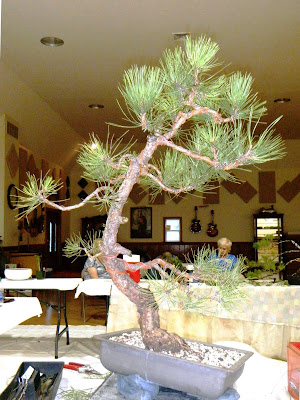In my last post, I mentioned the yamadori ponderosa that I intended to repot the following day.
I bought this Pinus ponderosa from Andy Smith of Golden Arrow Bonsai last summer. Andy collected it in 2017, and estimated it to be 40 years old at the time of collection. In August 2019 he brought the tree with him when he visited Fort Wayne to lead a B.Y.O.T. workshop (saving me shipping costs, which I much appreciated.) We did the first styling in that workshop. Here are a few pictures.
 |
| My new ponderosa as Andy delivered it. |
 |
The work in progress.
(The cluttered background in this picture is due to an unavoidable camera angle.) |
 |
| Finished for the day. You can see Andy Smith in the background, in the blue cap. |
The tree spent the winter outdoors but sheltered from the wind, and by early this month the buds were swelling noticeably. However, temperatures were swinging up and down like a roller coaster, with daytime highs often above freezing but nightly lows frequently below. I finally got an almost week-long stretch of mild weather, and before the foliage opened too far for repotting to be safe this spring. Thankful for the opportunity, I went ahead.
Here's the tree before work began. I anticipated that I might have to adjust the planting angle once I saw the nebari. Also, some topmost branches had gotten disarranged when I finagled the tree into my car after the workshop last August.
 |
| April 7, 2020. Ready to repot. |
The pot, a gift from my friend Dave Burke, is an unglazed ceramic rectangle. An aeration layer of scoria, particles between 6 and 7½ mm in size, is ready in the bottom.
 |
| This pot is a little shorter and a little narrower, but also a little deeper, than the pot the tree came in. Volumes are similar. |
I've mentioned before, usually to the surprise of friends in this country, that pines and their close relatives are exotic to me. I grew up in the tropics, and tropical rainforest trees are my "default" models, all the way down to my subconscious, of what to expect from trees and shrubs. I've killed more pines and spruces over the years than I care to mention, as I've slowly learned the specifics of how they differ from tropicals and just how they should be handled as a result.
I've learned a lot of those specifics in recent years from Ryan Neil and the Bonsai Mirai live streams. (Unlike me, Ryan grew up surrounded by pines, if I understand correctly.) For one thing, it's finally gotten thru my head that a conifer should be never be fully bare-rooted when repotting. Never. Just halfway. I tried two of Ryan's techniques which I hadn't used before, the first of which has to do with that "bare-rooting only halfway": I carefully removed about half the existing potting mix from a "window" in the approximate center of the root mass and more or less under the base of the tree. Here's a picture from below; you can see light coming thru some gaps between structural roots (red arrows).
 |
| The "window" in the original soil mass. |
(Ryan Neil refers to the area immediately under the base of a tree as its sin - pronounced "sheen" and only coincidentally written in our alphabet the way it is! He says a healthy root mass in the sin is very important to the tree's long-term health, but I don't yet fully understand why.)
I also used Ryan's anchoring approach - the second of his techniques I tried for the first time - using stainless-steel wire and small wood screws. I think the results were good, but I have no pictures.
As I mentioned in my last post, I decided to use his 1:1:1 mix of akadama, pumice and scoria; all particles were between 2 and 6 mm. That's a smaller average particle size than Ryan uses for ponderosas, but his location gets 52 inches of rain per year to my 40, so I'm not especially concerned. Also, the new pot is not especially shallow, a factor that helps drainage. Mycorrhizal inoculant was sprinkled over the roots before soil was filled in.
 |
| For any who don't recognize them, the pumice is white, the scoria is black and the akadama is tan. |
A large back root, which could not be removed now without endangering the tree, forced me to pot the tree farther forward in the pot than I intend it to eventually be. That root will be shortened at the next repotting, when I replace the outer "donut" of soil and leave the sin untouched. I will then also be able to adjust the front a little (clockwise as seen from above). A top dressing of shredded sphagnum finished things off.
 |
| That root adds interest, but constrains the planting position. Guy wire is a precaution. |
And that's all for this year. I'll fertilize the tree well, adjust some branches next year, and repot again in 2021.
 |
| The tree in its new home. |
Well, almost all: the spring weather wasn't quite done with me and the tree yet. Tonite our low is forecast to again be below freezing and the cold is supposed to stay around for the next three days. Even a ponderosa's roots shouldn't be exposed to such chill right after repotting. So the tree is now on the ground next to the south wall of our garage, under the overhang of the roof, screened from the prevailing wind, and with the pot and its contents swaddled in a fabric made for cold protection of early-season vegetables.
 |
| Tucked in until the weekend. |
Ciao for now!
:-) :-) :-)













